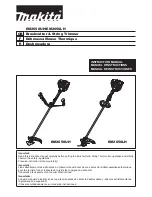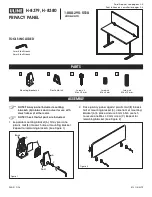
4-14
F-605-1022
3 Row Coil Tine and Reel Adjust-
ments
1.
The optional 3 row coil tine and reel attachment
consists of a 3 row coil tine and finishing reel
combination harrow that operate independently from
each other. The 3 row coil tine reel harrow performs
best in clean dry ground with minimal residue, to level,
break up clods, and firm soil.
2.
The 3 row coil tine harrow option has 3 rows of 7/16”
diameter x 18” long spring steel tines on 16” centers
with overall spacing of 2” working centers. Tine rows
are on 14” centers for enhanced residue flow. Tine
tooth angle is also adjustable for each tine bar end
section. Each harrow section is mounted with two
arms with spring-loaded down pressure. Tine teeth
may individually rotate freely backward if needed for
backup protection
WARNING
3.
In general tine harrows have better capabilities for
handling more residue and wetter conditions. When
operating the coil tine harrow, a more vertical tine
tooth angle will make the harrow more aggressive. A
lower/flatter tine angle will make the harrow less
aggressive but will handle more residue and wetter
conditions. To change the tine angle, raise the harrow
off the ground. Remove the harrow pin from both
angle adjustment tubes per tine gang bar tube
.
Rotate the angle adjustment tubes
forward
(less
aggressive)
or
rearward
(more
aggressive) and reinstall both spring clip pins. Repeat
the tine adjustment for each tine gang bar tube and
harrow section.
4.
Each coil tine harrow may be adjusted for spring
pressure as well
. Raise the tine
harrow off the ground. Remove the clevis pin from the
spring tube and install in a heavy or light setting as
needed.
Excessive spring pressure and tine angle
can overload harrow spring.
NOTE
The tine teeth will hang straight down when the
implement is raised, and the tines will be slightly
lower than the sweeps.
5.
The 12” diameter reel consists of nine 3/4” diameter
round bars with a chevron shape for smoother
rotation. The reels have no inner shaft to reduce
plugging in wetter conditions. The reels operate
independently of the 3 row spike with two spring
loaded arms per reel to maintain consistent down
pressure. Install the round bar cheveron reels with the
cheveron direction matching typical tractor tire
direction. A 12” diameter spiral wound reel with 1/4 x
1-1/2 angled blades is also available. The blades on
flat bar reels are angled for more aggressive action.
Install the reels as shown
Figure 4-13: Flat Reel
6.
To adjust the reel height, loosen the locking hex nut
against the threaded spring end
.
7.
Raise or lower the reel by turning the head of the
spring bolt, and then re-tighten the locking nut against
the spring end. Initially set the bottom of the reel even
with the bottom of the sweeps. In lighter or wet soils,
you may need to raise the reels slightly above the
sweeps. Setting the reels too low may cause the reels
to plug or push dirt. Excessive reel depth/down
pressure may hold the rear of the field cultivator out of
the ground.
8.
Reels are equipped with maintenance-free bearings.
Know and verify actual implement height and
width before transporting. Attachments may
increase the overall height and width of the
implement. Use caution when transporting near
power lines. Electrocution can occur without
direct contact.
FRONT
Summary of Contents for 9650
Page 4: ......
Page 21: ...2 7 TABLE OF CONTENTS Table provided for general use NOTES...
Page 31: ...2 17 TABLE OF CONTENTS Table provided for general use NOTES...
Page 35: ...2 21 TABLE OF CONTENTS Table provided for general use NOTES...
Page 39: ...2 25 TABLE OF CONTENTS Table provided for general use NOTES...
Page 43: ...2 29 TABLE OF CONTENTS Table provided for general use NOTES...
Page 47: ...2 33 TABLE OF CONTENTS Table provided for general use NOTES...
Page 51: ...2 37 TABLE OF CONTENTS Table provided for general use NOTES...
Page 55: ...2 41 TABLE OF CONTENTS Table provided for general use NOTES...
Page 59: ...2 45 TABLE OF CONTENTS Table provided for general use NOTES...
Page 63: ...2 49 TABLE OF CONTENTS Table provided for general use NOTES...
Page 67: ...2 53 TABLE OF CONTENTS Table provided for general use NOTES...
Page 71: ...2 57 TABLE OF CONTENTS Table provided for general use NOTES...
Page 75: ...2 61 TABLE OF CONTENTS Table provided for general use NOTES...
Page 79: ...2 65 TABLE OF CONTENTS Table provided for general use NOTES...
Page 83: ...2 69 TABLE OF CONTENTS Table provided for general use NOTES...
Page 87: ...2 73 TABLE OF CONTENTS Table provided for general use NOTES...
Page 91: ...2 77 TABLE OF CONTENTS Table provided for general use NOTES...
Page 95: ...2 81 TABLE OF CONTENTS Table provided for general use NOTES...
Page 99: ...2 85 TABLE OF CONTENTS Table provided for general use NOTES...
Page 103: ...2 89 TABLE OF CONTENTS Table provided for general use NOTES...
Page 125: ...3 19 TABLE OF CONTENTS Table provided for general use NOTES...
Page 129: ...3 23 TABLE OF CONTENTS Table provided for general use NOTES...
Page 133: ...3 27 TABLE OF CONTENTS Table provided for general use NOTES...
Page 137: ...3 31 TABLE OF CONTENTS Table provided for general use NOTES...
Page 141: ...3 35 TABLE OF CONTENTS Table provided for general use NOTES...
Page 157: ...4 3 TABLE OF CONTENTS Table provided for general use NOTES...
Page 165: ...4 11 TABLE OF CONTENTS Table provided for general use NOTES...
Page 174: ...4 20 F 605 1022 TABLE OF CONTENTS Table provided for general use NOTES...
Page 178: ...5 4 F 605 1022 TABLE OF CONTENTS Table provided for general use NOTES...















































